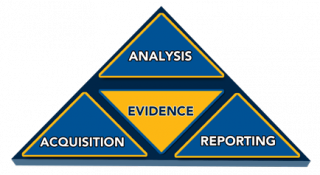
Posted May 22, 2015

Luskin's Learning Psychology Series-No. 19
Forensic Media Psychology (FMP) is growing as a professional sub-specialty in psychology. Forensic media investigation identifies and analyzes facts in media, digital management and property rights. FMP combines expertise in understanding cognitive illusions, the effect of associations influenced by remembering,experience and fact finding. FMP is being driven by civil and criminal litigation. Court decisions are “paving the way,” decision by decision, as the techniques and technology of this new discipline improve. The judiciary is evolving Forensic Media Psychology through precedent after precedent.
Applying psychology in litigation offers a broad palette of insights for decision making. Every form of communication is growing exponentially. Identifying what is real and what is not, is central to FMP in the same way that forensic medicine is central for the medical examiner. The professional in this new field might be called a Forensic Media Examiner. Understanding forensic media psychology is important for attorneys, advertising, marketing and sales executives, teachers, the military, politicians and those in public policy, health care, entertainment, education and commerce.
Defining Forensic Media Psychology (FMP). Forensic psychology has been defined as addressing issues in disputes related to law and the legal system. In fact, the word "forensic" comes from the Latin word "forensis," meaning "of the forum," where the law courts of ancient Rome were held. Today, the term forensic has grown to embrace the many scientific and behavioral principles and practices applied to fact finding, analysis and explanations of present and past events. Psychology identifies and explains intent or behaviors in disputes being litigated. Forensic media psychology applies forensic psychology to the behaviors triggered by all forms of media such as pictures, graphics and sound.

FMP has emerged from the news and entertainment media’s fascination with the “intersection” of psychology, intellectual property, production values, globalization and law (Vitriol, 2008). The explosion of social media has amplified the importance of forensic media psychology in the same way new medicine has revolutionized health care. The news is filled with cases of cyber-terrorism, cyber-bullying and theft of intellectual property. Reports of shootings, unruly crowd behavior, train accidents, robberies, civil disobedience, sex and war fueling the recent explosion in its application. Battles for rights, ownership, money, control, power and attention underscore the need for forensic media psychology. FMP is an applied tool for analyzing individual and societal behaviors to better understand news and world events.
Through the use of rigorous research and systematic observation, psychological researchers can understand the mental constructs that provoke informed behavior, reveal uninformed bias and belief systems and the many ways perceptions may be altered (T. T. Luskin, Luskin, B.J., 1998).
Memory manipulation includes remembering and experience in addition to facts. We now know that the mind may frequently struggle to tell the difference between fantasy and reality. Perception and understanding can be manipulated. While a picture may once have been worth a thousand words, today's media can influence and alter human perception with all manner of illusions (Hsu, April 3, 2012). In addition, faulty eyewitness memory and controversial jury decision-making in civil and criminal litigation are the subject of frequent debate. Sensationalism in news reportage and the integrity on the part of those who deliver our news, make today's media coverage controversial. The increasing use of body-cams and the proliferation of up-loadable cell phone videos, added to the blurred delineation between news and entertainment, rivet the coveted viewer attention that translates into audience share in the news media industry.

What is real? Discovering what is real and what is fabricated presents a whole new field of investigative opportunity. It takes knowledge of FMP and expert analysis to figure these situations out. Understanding the difference between the brain and the mind, and the implications for individual and group behavior, is a part of FMP. Magnetic resonance imagery (MRI) technology is a 21st century phenomenon that is accelerating our understanding of how and why people behave as they do. Some images are transmitted through the eye, others retrieved from memory. There are tricks that may alter perception through various types of intentional and unintentional manipulation. In litigation, the dependence on accurate memories has an inherent risk of distorted recollections that can lead to wrongful conviction or incorrect decisions. Simply put, forensic media psychology is a powerful tool that may be applied to establish the reality and validity of perceptions.
FMP applies psychology to the law. Legal researchers search for understanding regarding how verdicts are influenced by the subjective interpretation of facts, group dynamics, social psychology and societal influences. Successful deception and believability depend on a convincing presentation. Some behavioral cues, such as perspiration and body language, not only “betray a lie but a misconstrued statement of honesty as well” (Spence et al., 2004).
Examples of situations requiring understanding through forensic media psychology investigations include:
1. Storytelling in film, television and gaming
2. Simulations in teaching and learning
3. Augmented reality simulations in military actions and tactics
4. Characterizations in plastic surgery
5. Formation of political opinion
6. Recent radicalization of susceptible individuals to embrace specific belief systems
7. Settling intellectual property and other rights disputes through the forensic analysis of media assets.
Understanding basic theories in psychology is fundamental to understanding the behavior of society and individuals. FMP requires a thorough grasp of (1) semantics and the many ways language may be applied, (2) semiotics including the study, use and application of symbols and (3) synesthetics, that embraces sensory psychology (Luskin, 2002).
Media Essential ReadsIn an educational program, learning the basics of forensic media psychology may be achieved by following a three-step approach that includes: (1) conducting an overview of basic theories and concepts in psychology that may then be applied to média, (2) pursuing an in depth examination of a specific area of special Interest and (3) selecting an appropriate research methodology as a framework for forensic media psychology as it applies to a specific situation.
FMP offers employment opportunity. There is opportunity in litigation, media production, such as film, television, social media, communication technology (smart phones) audio and print products, public policy and government, commerce (including sales, marketing, product design), health care, simulations for teaching, learning and the military (B. Luskin, L. Friedland., 1998).
The Future. In years ahead, law schools, schools of psychology, film, television and media, business schools and schools of public policy will offer seminars, courses, certificates and degrees in Forensic Media Psychology.
Author
Dr. Bernard Luskin, LMFT is president emeritus of the Society for Media Psychology and Technology of the American Psychological Association and Chancellor emeritus, Ventura County Community College District. Luskin has been CEO of eight colleges and universities, CEO of Fortune Class Media and Telecommunications Companies, including Philips Interactive Media and Jones Education Networks. He has received numerous recognitions for contributions to psychology, media, technology and education. Acknowledgements include lifetime achievement awards from the American Psychological Association, Irish Government and European Commission and including two Emmys from The Academy of Television Arts and Sciences. Please email comments to: BernieLuskin@gmail.com
Special thanks to Dr. Toni Luskin for her assistance in editing and to Janeene Nagaoka for the excellent graphics.
References
Hsu, J. (April 3, 2012). Why "Uncanny Valley" Human Look-Alikes Put Us on Edge. Innovation News Daily. Retrieved from http://www.scientificamerican.com/article/why-uncanny-valley-human-look…
Luskin, B. J. (2002). Casting the Net Over Global Learning (1 ed. Vol. 1). Los Angeles: Griffin.
Luskin, B. J. Friedland., L. (1998). Division 46 Taskforce Study of New Career Opportunities in the Emerging Field of Media Psychology (46, Trans.) (1 ed., Vol. 1, pp. 101). Los Angeles: American Psychological Association.
Luskin, T. T., Luskin, B.J. (1998). Media, Psychology and the Socio-Psychomedia Effect (1st ed. Vol. 51). Chicago: International Engineering Consortium.
Vitriol, J. (2008). The Reality of Forensic Psychology. Observer, 21(3). Retrieved from http://www.psychologicalscience.org
Spence, S.A., Hunter, M.D., Farrow, T.F.D., Green, R.D., Leung, D.H., Hughes, C.J., & Ganesan, V. (2004).A cognitive neurobiological account of deception: Evidence from functional neuroimaging. Philosophical Translations of the Royal Society of London, Series B: Biological Sciences, (2004) 359, 1755-1762.